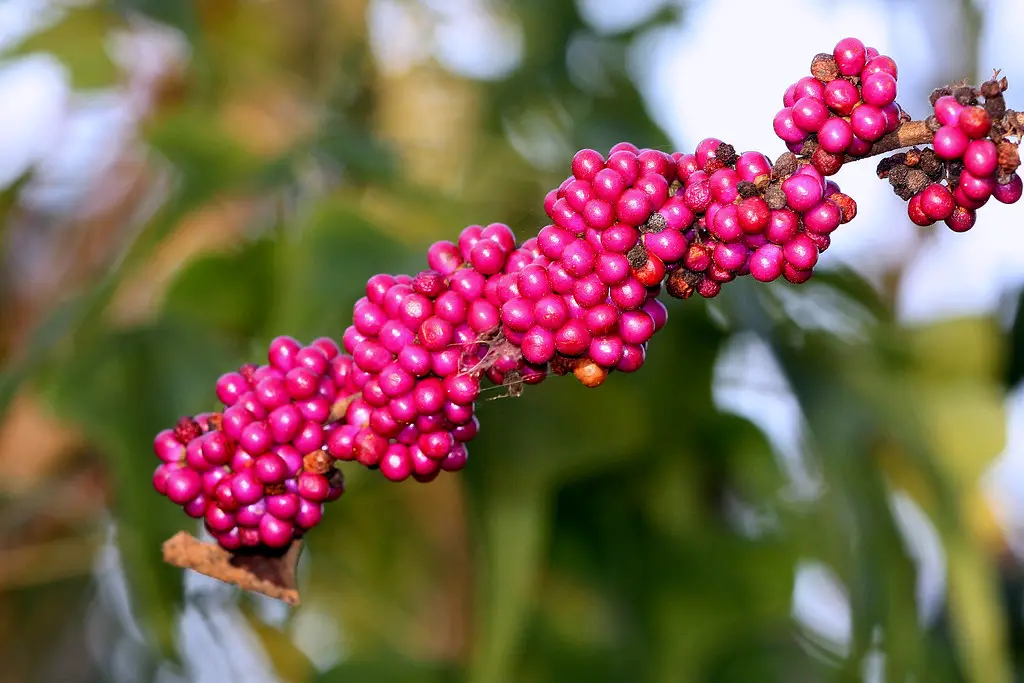The American beautyberry is a striking native shrub, renowned for its dazzling display of bright purple or magenta berries that grow in clusters around the stem. Scientifically named Callicarpa americana, this deciduous shrub blooms small lavender-pink flowers in the summer, followed by the vibrant berries that persist into the winter.
Found natively in the southeastern United States, American beautyberry is often used as an ornamental feature in gardens. Its beautiful appearance and natural ability to attract wildlife, including birds and butterflies, make it a favorite among garden enthusiasts and nature lovers alike.
In addition to its aesthetic appeal, American beautyberry has a rich history of medicinal and practical uses. Native American tribes used the leaves and roots for various medicinal purposes, while early settlers used crushed leaves as a mosquito repellent. Now, let’s dive into the details of this fascinating plant.
| Attribute | Details |
|---|---|
| Common Names | American beautyberry, French mulberry |
| Botanical Name | Callicarpa americana |
| Family | Verbenaceae |
| Plant Type | Deciduous shrub |
| Mature Size | 3-8 feet tall |
| Sun Exposure | Full sun to partial shade |
| Soil Type | Well-draining, acidic soil |
| Hardiness Zones | 7-11 |
| Native Area | Southeastern United States |
American Beautyberry Care
Caring for American beautyberry is relatively straightforward and manageable. This shrub is tolerant of various conditions and adaptable to different garden styles, making it an excellent choice for novice and experienced gardeners alike.
Proper care focuses on understanding the basic needs of the plant, including sunlight, water, and soil preferences. Once established, American beautyberry is known for its hardiness and low maintenance requirements.
Light Requirement for American Beautyberry
American beautyberry thrives in both full sun and partial shade. While it can tolerate various lighting conditions, it produces the most vibrant berry clusters and lush foliage when given ample sunlight.
Soil Requirements for American Beautyberry
This shrub prefers well-draining, acidic soil. Although adaptable to various soil types, it tends to grow best in soils rich in organic matter. Sandy or loamy soils that retain some moisture but prevent waterlogging are ideal.
Water Requirements for American Beautyberry
American beautyberry has moderate water needs. While it can tolerate some drought conditions once established, consistent watering during the growing season ensures optimal growth and berry production.
Temperature and Humidity
American beautyberry is suitable for hardiness zones 7 to 11. It prefers warm temperatures and can thrive in various humidity levels. It’s a resilient plant that can adapt to different climates within its hardiness range.
Fertilizer
A balanced fertilizer applied in the early spring can boost growth. Look for a general-purpose garden fertilizer and follow the instructions on the packaging. Over-fertilizing can lead to fewer berries, so use caution.
Pruning American Beautyberry
Pruning is essential to maintain shape and encourage vigorous growth. Trim the shrub in late winter or early spring, cutting back one-third of the branches. Removing old or damaged wood helps invigorate the plant.
Propagating American Beautyberry
American beautyberry can be propagated through softwood cuttings in the spring or summer. Take cuttings and place them in a soilless medium, keeping them moist and shaded until they root.
How To Grow American Beautyberry From Seed
Growing American beautyberry from seed is possible but slow. Collect seeds from ripe berries and plant them in a well-draining medium. Provide consistent moisture and patience, as germination can take several months.
Common Pests & Plant Diseases
Aphids
Manage with insecticidal soap or horticultural oil.
Powdery Mildew
Ensure proper air circulation and avoid overhead watering.
Common Problems With American Beautyberry
Sparse Berry Clusters
This may result from inadequate sunlight or over-fertilizing.
Leggy Growth
Caused by insufficient sunlight or lack of pruning. Adjust care as needed.
Pro Tips
- Plant American beautyberry near patios or windows to enjoy the beautiful berry display.
- Consider using it in a native or wildlife garden to attract birds and butterflies.
- Mulch around the base to retain moisture and suppress weeds.
- Monitor for pests and diseases, as prevention is easier than treatment.
- Experiment with planting companions like native grasses or ferns for a layered garden look.




